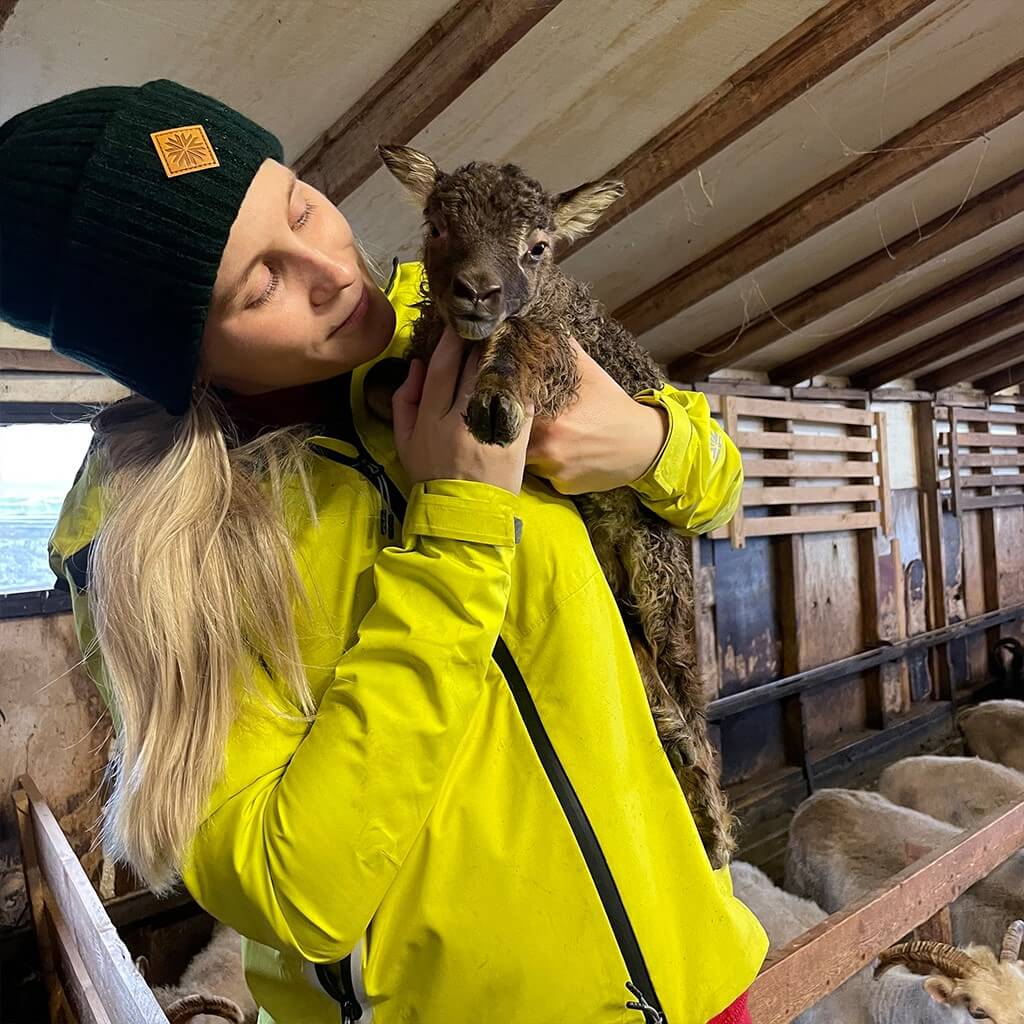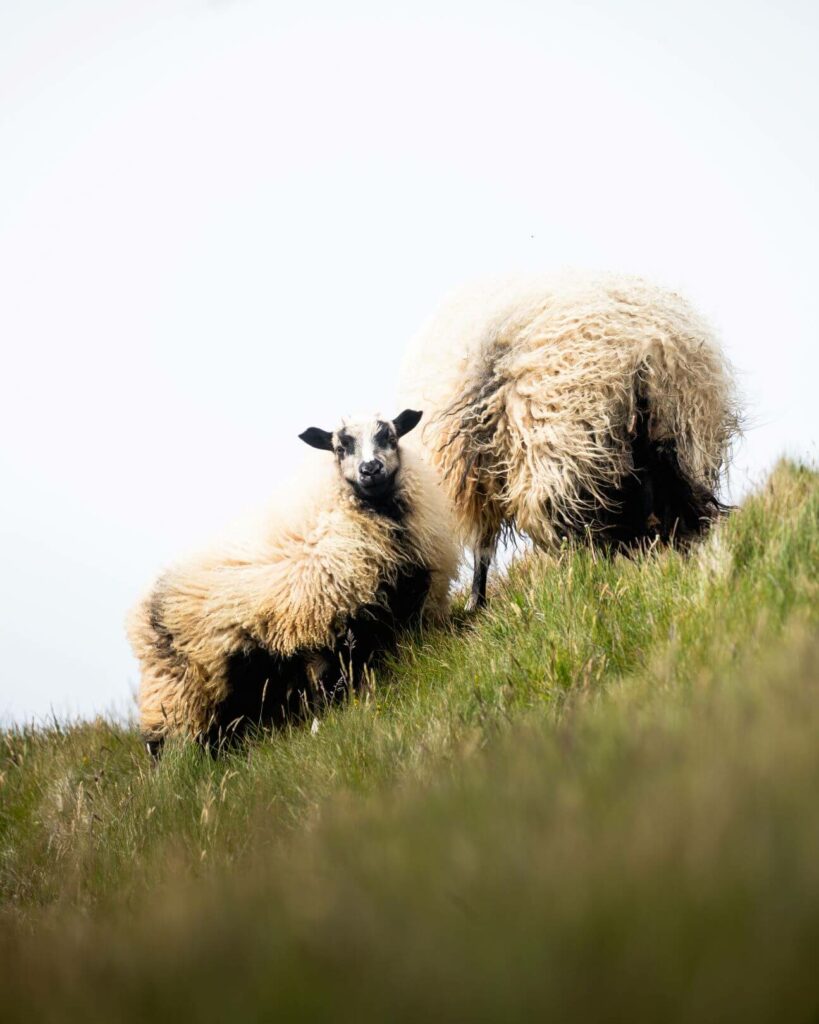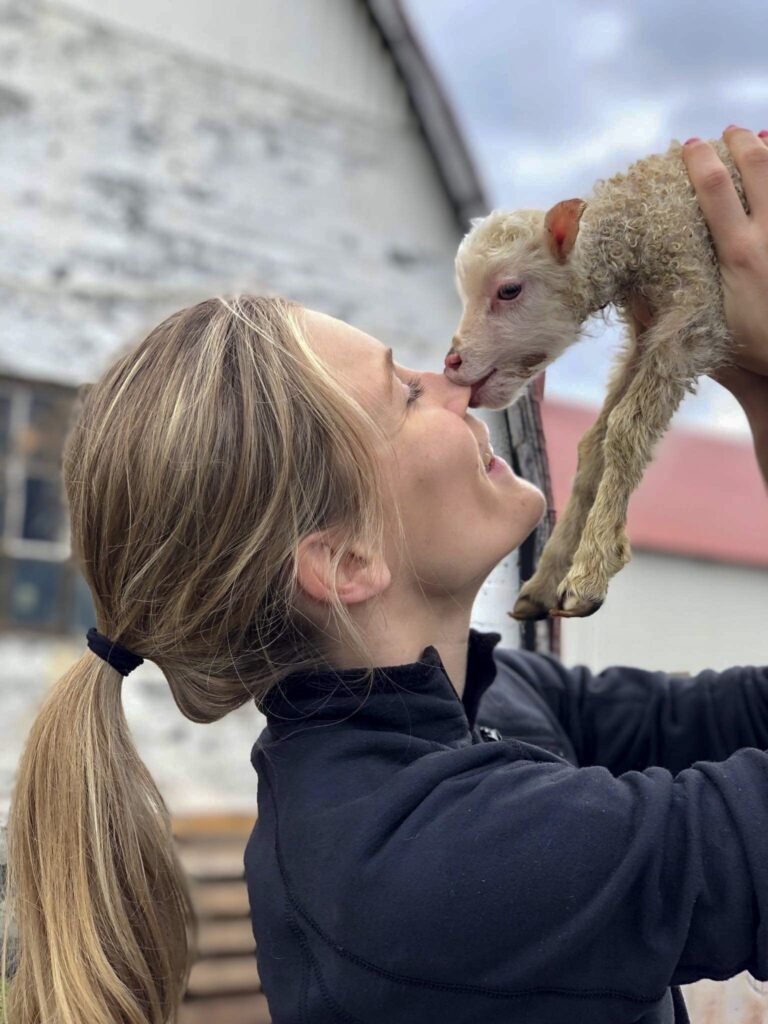An interview with Pálína Axelsdóttir Njarðvík of FarmlifeIceland
“Sheep are fun animals and they are just as different from one another as we are. Some have big personalities, are leaders who always know what they want, while others are happy just following the crowd. Some are excitable, always looking for adventure, while others are just content to be quiet,” says Pálína Axelsdóttir Njarðvík. She is the woman behind the Instagram page FarmlifeIceland, sharing snapshots of life on a traditional Icelandic sheep farm, and is also a frequent guest on Icelandic Lamb’s social media.

The lambing season
When we caught up with her, Pálína was in the middle of lambing at Eystra-Geldingaholt in Gnúpverjahreppur county. Sitting on either side of her were two sheep, Friði and Sunna, who occasionally snuck pats and hugs from Pálína during the video call. “They were both botte-lambs when they were little. Bottle-lambs often become our great friends,” Pálína says with a smile.
Home is where the heart is
Pálína was raised in the same part of Iceland as her mother’s family, Gnúpverjahreppur county. After primary school, she moved to Reykjavík to pursue her education and has had one foot in the city ever since. Her other foot is usually in Eystra-Geldingaholt, and indeed her heart and mind as well, which is clear to anyone who speaks to Pálína. “This is home,” she says. “My family is here and the roots are deep, I think,” she says, adding that she rarely spends more than two weekends in a row in the city. Then she starts to get impatient, she wants to get to the countryside and work in the open air. “I really enjoy being outside. There is a certain awareness involved in thinking about the animals and working around them,” she says.
The best time of the year
With that said, it should come as no surprise that Pálína packs a bag and heads east to Gnúpverja in the spring. It is precisely this time of year that she finds most enjoyable, the lambing and everything that comes with it. “As soon as it’s May, I don’t want to be anywhere else,” she says. “This is the best, welcoming the lambs and taking care of the sheep and lambs with the family. There is a round-the-clock watch and it’s never more than an hour between someone going to check on the sheep throughout the night,” she says. But why is that? “You don’t want to take any risks. Most of the time, the lambing goes well, but sometimes you need help to bring the lambs into the world. And then you have to be on the spot, ready to act,” explains Pálína, because there is a lot to think about during the lambing and everyone needs to work together. People take turns watching over the ewes, feeding the sheep, watching the lambs and making sure they thrive. “We’re in this together as a family,” says Pálína, who enjoys every minute of the lambing in the spring, whether it’s the long nights or the quiet days in between.

Animals deserve our respect
But rural life isn’t always about new life. Summer ends and the other side of the coin is revealed: shepherding, rounding up the sheep and the slaughtering season. Pálína admits that she has very mixed feelings about autumn. She really enjoys the roundup, but the
slaughter season is different. “It is difficult. I know it’s part of rural life, but I don’t like the slaughtering,” she says. “But it’s not supposed to be fun either. We are raising animals for meat and we have a duty to be kind to our animals while they live and in their death show them respect they deserve. If you can’t do that, you shouldn’t be a farmer,” says Pálína. She says she grew up with this attitude and that fortunately everyone she knows who has anything to do with farming is of the same opinion. “That’s how it should be.”
Not all meat is the same
When asked, Pálína says she believes that sheep in Iceland generally live a very good life. The farms are small and family owned, and the farmers have the sheeps’ best interests at heart. The sheep are allowed to roam free in the mountains during the summer and be outside as long as the weather permits. “I think it’s very important and I think, fortunately, more and more people are starting to think about this too,” she says. “Because we all know that the meat we eat doesn’t come from the refrigerated section at the store, if we think about it. And we should think about where our food comes from, because not all meat is the same. For example, Icelandic lamb has nothing in common with factory-produced pork from abroad,” she says and reiterates that as consumers, we are always taking a stand. “That’s why I always choose Icelandic meat, because I know what rules apply to animal welfare in Iceland, I know that the use of antibiotics is at an absolute minimum. But I don’t necessarily know how it is in other parts of the world. And I would never buy meat from animals knowing that they had lived in suffering. I’m not involved in supporting that kind of thing. That is not farming,” says Pálína.
Part of the national soul
But the raising of Icelandic sheep is not just about food production. It is intertwined with the nation’s history and has deep roots in the Icelandic national soul. It is an old cliché that the Icelandic sheep has kept the nation alive throughout the ages, both by giving us food and keeping us warm. But cliches are cliches for a reason. They speak of deep and abiding truths that may not be as obvious as they once were, but are true nonetheless. “I think a lot of people have moved away from that lately. There are a lot of people who don’t know a sheep,” says Pálína and laughs. It’s no wonder when only a small number of people live in the countryside. “That’s exactly why I think it’s important to share rural life with others.”

A life that most people find foreign
And then we come to the thing Pálína is probably best known for. She maintains the Instagram page FarmlifeIceland, where almost 270,000 people follow her on the farm all year round. It doesn’t matter if it’s the roundup, lambing or just an everyday breakfast on a cold winter morning. “I started posting a lot of sheep pictures on my personal account and was afraid that my friends might not find it exciting enough,” she laughs. “But at some point I decided to try to create something of a window into country life, maybe someone would find it interesting.” And that turned out to be the case. “I didn’t tell anyone about it, but followers immediately started piling up and it just got better from there, much more than I had ever imagined,” says Pálína. “I even have followers who have followed me since the beginning. And I just really enjoy showing this beautiful relationship that develops between people and animals in the countryside, because for most people in the world, this country life is very foreign,” says Pálína Axelsdóttir Njarðvík.
